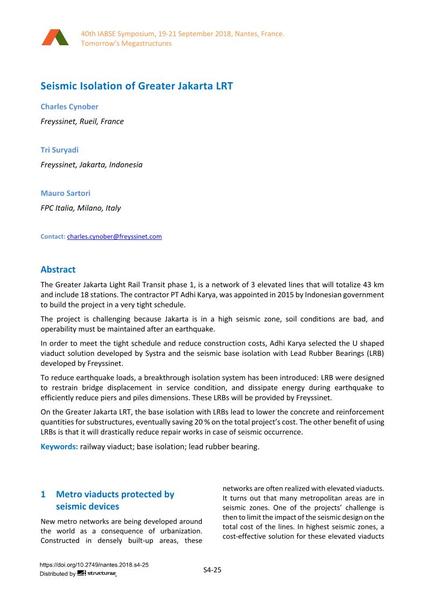Seismic Isolation of Greater Jakarta LRT

|
|
|||||||||||
Détails bibliographiques
| Auteur(s): |
Charles Cynober
(Freyssinet, Rueil, France)
Tri Suryadi (Freyssinet, Jakarta, Indonesia) Mauro Sartori (FPC Italia, Milano, Italy) |
||||
|---|---|---|---|---|---|
| Médium: | papier de conférence | ||||
| Langue(s): | anglais | ||||
| Conférence: | IABSE Symposium: Tomorrow’s Megastructures, Nantes, France, 19-21 September 2018 | ||||
| Publié dans: | IABSE Symposium Nantes 2018 | ||||
|
|||||
| Page(s): | S4-25 | ||||
| Nombre total de pages (du PDF): | 6 | ||||
| DOI: | 10.2749/nantes.2018.s4-25 | ||||
| Abstrait: |
The Greater Jakarta Light Rail Transit phase 1, is a network of 3 elevated lines that will totalize 43 km and include 18 stations. The contractor PT Adhi Karya, was appointed in 2015 by Indonesian government to build the project in a very tight schedule. The project is challenging because Jakarta is in a high seismic zone, soil conditions are bad, and operability must be maintained after an earthquake. In order to meet the tight schedule and reduce construction costs, Adhi Karya selected the U shaped viaduct solution developed by Systra and the seismic base isolation with Lead Rubber Bearings (LRB) developed by Freyssinet. To reduce earthquake loads, a breakthrough isolation system has been introduced: LRB were designed to restrain bridge displacement in service condition, and dissipate energy during earthquake to efficiently reduce piers and piles dimensions. These LRBs will be provided by Freyssinet. On the Greater Jakarta LRT, the base isolation with LRBs lead to lower the concrete and reinforcement quantities for substructures, eventually saving 20 % on the total project’s cost. The other benefit of using LRBs is that it will drastically reduce repair works in case of seismic occurrence. |
||||
